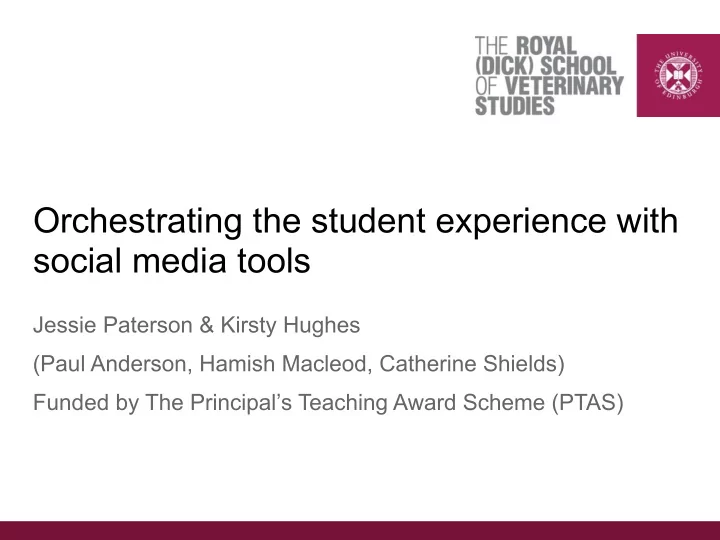

Orchestrating the student experience with social media tools Jessie Paterson & Kirsty Hughes (Paul Anderson, Hamish Macleod, Catherine Shields) Funded by The Principal’s Teaching Award Scheme (PTAS)
Hypothesis • Can we classify types of “interactions models” supported by different social media & online tools? • Could this classification be helpful for – Categorising – Selecting tools For particular pedagogic objectives?
Methodology 11 semi-structured interviews with teaching staff across range of disciplines within University asking about tools used in teaching:- • “Tool” loose definition but some sort of group interaction/ activity • Covered UG and PG teaching • From Teaching Fellows to Directors of Teaching – Views generally of “their” teaching on their course rather than discipline/programme • Not necessarily representative of discipline but seen as someone interested in teaching
What tools?
Issues surfacing Many including:- • Privacy – who can see what is happening? • Data protection – external tools & student data? • Inclusivity/accessibility (e.g. if students using Facebook groups who excluded?) • Speed change/changes in what available (e.g. mobile phone features) BUT main issue:- Time to understand/develop/incorporate into teaching
How might this be made easier – Interaction Models? • Is it helpful to think about what interactions among students we want to achieve? • Can we classify the interactions supported by different social media tools? • If so, would this be useful in identifying different tools producing similar interactions so can choose which to use for particular situations?
Possible classification Very simple classification: – who is communicating with whom, in what order? – no analysis of message content NB • Same colour = same message • Different colour = different message
Example 1 - dissemination (simultaneous) • lectures • online videos • student presentations • web pages • twitter One person giving out the same message to all
Example 2 – Fully connected • face-to-face group discussion skype, second life • • virtual classroom • twitter All giving out the same message to others & all receiving
Compound Interactions There were quite a few cases of more complex processes - usually sequential compositions of individual interactions For example - Critical Friend… • – A group of students collaborate to create (closed) Wiki pages – The Wiki pages are then opened up to a wider student group – The other students comment on the Wiki pages – The original students revise their pages – The Wiki is presented for marking – The staff return marks and comments
How it might work? • A lecture as – Information delivery Or • A lecture with – Clickers or online polling to gauge understanding � – Peer instruction; discussion with peers prior to re-voting on answer
Questions • Should we consider the message content? • If yes what level of message content should we consider? – Is a very coarse classification such as "question and answer“ enough? – Is a more detailed classification needed? • Is it important to consider the timing of the interactions? – Synchronous or asynchronous
What next? • Further analysis of data • Look at more formal techniques for describing models e.g. calculus of communicating systems? BUT • Is this useful? – Feedback from our colleagues has suggested that for some people it is useful even just thinking about interactions in this way as it provides new insights
Contacts • Jessie.Paterson@ed.ac.uk • Kirsty.Hughes@ed.ac.uk
Recommend
More recommend